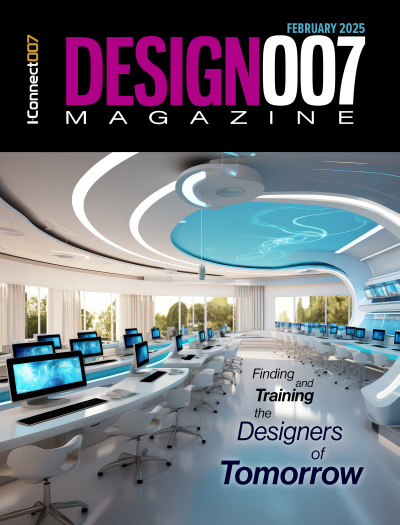-

- News
- Books
Featured Books
- design007 Magazine
Latest Issues
Current Issue
Designing Through the Noise
Our experts discuss the constantly evolving world of RF design, including the many tradeoffs, material considerations, and design tips and techniques that designers and design engineers need to know to succeed in this high-frequency realm.

Learning to Speak ‘Fab’
Our expert contributors clear up many of the miscommunication problems between PCB designers and their fab and assembly stakeholders. As you will see, a little extra planning early in the design cycle can go a long way toward maintaining open lines of communication with the fab and assembly folks.

Training New Designers
Where will we find the next generation of PCB designers and design engineers? Once we locate them, how will we train and educate them? What will PCB designers of the future need to master to deal with tomorrow’s technology?
- Articles
- Columns
Search Console
- Links
- Media kit
||| MENU - design007 Magazine
SMTA UHDI Symposium 2025, Part 1: Challenges and Solutions
January 28, 2025 | Marcy LaRont, I-Connect007Estimated reading time: 7 minutes
The first morning session concluded with a presentation by John Johnson of American Standard Circuits (ASC), who discussed a variety of UHDI fabrication methods and the many tradeoffs that this technology entails. John began by defining UHDI technology, to name a few, as a pitch of 0.5 mm and below, 75 micron or below high-density circuitry, typically multiple lamination and plating cycles, lines and spaces less than 65 microns, and tight impedance control at ±3-5%. He said the advantages of UHDI include fewer layers, size and weight reduction, improved RF performance and signal integrity, and better overall reliability.
Contrary to what many people believe, he said, UHDI is actually produced at a lower overall manufacturing cost. John is clearly passionate about his work. “For a guy who remembers when he struggled to get .005" trace and space, getting a half-mil trace brought tears to my eyes,” he said. To conclude, John addressed some possible scenarios, asking “Can I do this with UHDI?” It was a great way to showcase the tradeoffs and best approaches to using this technology. When it comes to UHDI, “We live in an ‘it depends’ world,” John said. He ended on a note of confidence, reinforcing the history of innovation and adaptability displayed by the companies that make up our industry throughout the decades. “Continually, our industry will find solutions,” he said.
After a short networking break, Stephen Chavez, principal technical product marketing manager at Siemens, led the second morning session on PCB design and DFM. He directed his audience to Happy Holden’s column on UHDI materials in the January 2025 issue of PCB007 Magazine, which features content by Paul Cooke. Steph said that PCB designers can no longer design with blinders on. DFM techniques must now consider not only cost and reliability but also supply chain resiliency and the ability for companies to make manufacturing decisions earlier in the process. He further emphasized that with UHDI, designers must have a relationship with suppliers to be successful in your DFM. “DFM is assistive technology with the objective of preventing catastrophic failures, like Lane Assist in a car,” he said. Designers must truly understand what happens to their designs downstream in the manufacturing process. “Just because you can design something, that doesn’t mean you should,” Steph said.
Designers and design engineers need to do more with less, and they must understand far more than designers of the past (think mechatronics). PCB designers need to think like electrical engineers and have some solid signal integrity expertise, further highlighting the essential role of collaboration. After the presentation, someone remarked that DFM is just one part of the whole equation: Designers must “design for” manufacturing, assembly, test, automation, AI, and sustainability.
Zach Peterson, owner of Northwest Engineering Solutions (NWES), then spoke about UHDI crosstalk penalties with UHDI. He examined characteristic impedance, odd-mode impedance, the 3W rule, and differential crosstalk. Zach showed data having alternated the variables of thickness, spacing, and material types to look at signal integrity and crosstalk effects as well as the reduction of channel bandwidth. He will be presenting at the IEEE Ethernet Alliance at DesignCon 2025 this week.
The morning sessions concluded with Michael Sivigny of CeTaQ Americas shifting our attention to SMT equipment for UHDI assembly, focusing on printers and placement machines. “We expect these machines to work 24/7, and ignore necessary maintenance to avoid any downtime,” he said. Michael explained how to properly prepare assembly equipment for UHDI, emphasizing continuous measurement, analysis and machine adjustment. The goal with printer equipment is print offset centering, and self-centering of components during reflow is declining with these technologies.
Going forward, Michael said there must be printer offset stroke-dependent adjustments in the X, Y and Theta directions. Print force matters, and too many equipment manufacturers do not include print force information in their brochures. To underscore these points, he shared that 90% of all new printers tested fail to meet their OEM specs; 16% of them perhaps never will without deep diagnostics, with an average 31% initial placement failure and a 10% final placement failure. At the bottom of each slide was the phrase, “If you don’t measure, you don’t know.” I found this to be so true. When was the last time you had your printer calibrated?
At this point in the day, our heads were full, and it was time for our baseball field lunch and more networking, allowing for a recharge before the afternoon’s equally packed schedule of presentations.
Read Part 2 of the UHDI symposium review tomorrow.
For more information on the SMTA UHDI symposium and the continuing dialogue around UHDI, I encourage you to reach out to Tara Dunn of SMTA for more information. We are also quickly approaching IPC APEX EXPO in March, which will spend a lot of time on UHDI and advanced packaging throughout their technical conference and special sessions. So, make sure to check those out.
Page 2 of 2Suggested Items
Real Time with... IPC APEX EXPO 2025: Emerging Trends in Design and Technology
04/16/2025 | Real Time with...IPC APEX EXPOAndy Shaughnessy speaks with IPC design instructor Kris Moyer to discuss emerging design trends. They cover UHDI technology, 3D printing, and optical data transmission, emphasizing the importance of a skilled workforce. The role of AI in design is highlighted, along with the need for understanding physics and mechanics as designs become more complex. The conversation concludes with a focus on enhancing math skills for better signal integrity.
Real Time with... IPC APEX EXPO 2025: Insights into PCB Design and Manufacturing with Polar Instruments
04/03/2025 | Real Time with...IPC APEX EXPOErik Bateham discusses Polar's latest book, which enhances insights for PCB designers and manufacturers. The book, "The Designer's Guide to... More Secrets of High-Speed PCBs," features a guest chapter on 2D via design modeling. Erik highlights the industry's shift towards UHDI and the challenges in measuring at micron levels.
Electroninks' MOD and iSAP Game Changers
03/25/2025 | Marcy LaRont, PCB007 MagazineElectroninks, a prominent player in particle-free conductive inks, recently announced an exciting new range of metal-complex inks for ultra high density interconnect (UHDI) technology. At the SMTA UHDI Symposium in January, Mike Vinson, COO of Electroninks, gave a presentation on this line of MOD inks, which are versatile and suitable for a range of applications that require ultra-dense, miniaturized, and high-frequency technology. Mike says his technology is a game changer and will revolutionize UHDI circuit fabrication.
I-Connect007 Editor’s Choice: Five Must-Reads for the Week
03/07/2025 | Andy Shaughnessy, I-Connect007It’s been a busy week. My must-reads include articles and news items on global trends and challenges, groundbreaking technology, the hunt for the elusive young PCB designers, and some personnel changes. We also have a great column on the value of following up and keeping promises. We’re all guilty of “dropping the ball” from time to time, aren’t we?
Are Domestic Assemblers Ready for the Next Level of Electronics Miniaturization?
02/19/2025 | Chrys Shea, SHEA Engineering ServicesUHDI technology is more than another evolutionary level of miniaturization. It’s a fundamental change in how we create circuit boards, on a scale potentially as impactful as the transition from through-hole to surface mount was 40 years ago.


